Western Digital Caviar Green 3TB and My Book Essential 3TB Drives Reviewed
by Anand Lal Shimpi on October 19, 2010 1:43 PM EST- Posted in
- Storage
- HDDs
- Western Digital
- 3TB
Let’s Go Outside: My Book Essential
Western Digital also sent along the My Book Essential, an external version of the 3TB Caviar Green. Unlike Seagate’s GoFlex Desk, the My Book Essential doesn’t have an option for interfaces: USB 3.0 is all you get. Obviously USB 3.0 is backwards compatible with USB 2.0 on the host connector side.
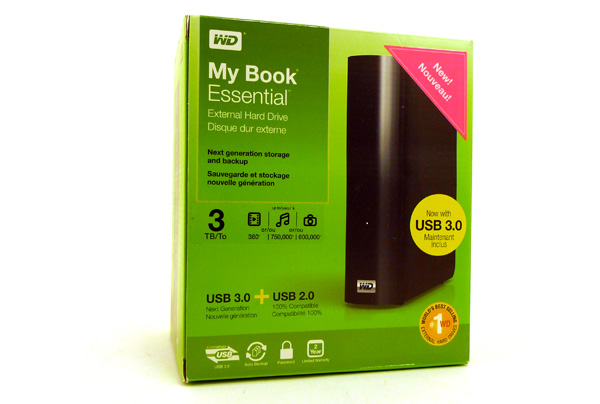
The first thing I wanted to test with the My Book Essential was how well it kept the drive cool. Remember the Caviar Green is a 4 platter sub-6000 RPM drive compared to the 5-platter 7200 RPM design in the GoFlex Desk, so temperatures should inherently be lower. To make sure the drive never gets too hot Western Digital has a grate that runs along the top, spine and bottom of the My Book Essential. A pair of rubber feet prop the drive up a few millimeters off of the ground to allow air in from below.The ventilation story is a lot better than what I encountered with the GoFlex Desk.
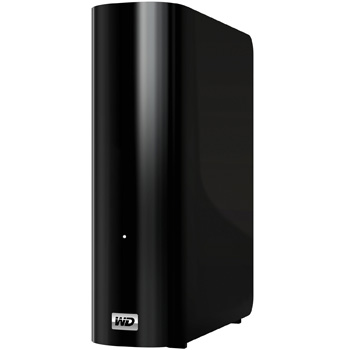
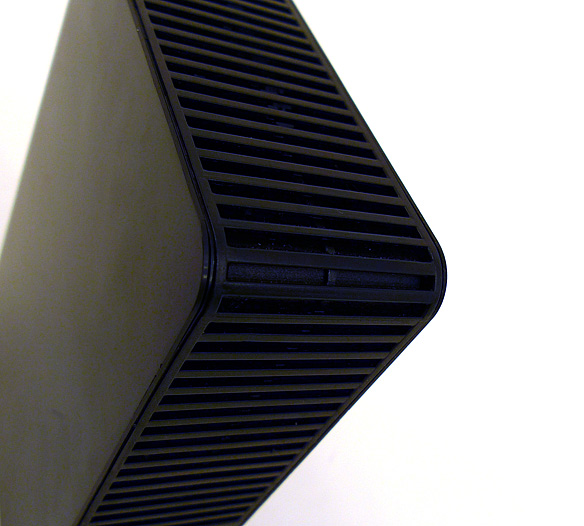
As a result, temperature is a non-issue. Here’s the drive at idle and after over an hour of use:
| Thermal/Power Comparison | |||||
| Idle | Load | Power Consumption (Idle/Load) | |||
| Western Digital My Book Essential 3TB | 34C | 49C | 5.30W / 9.60W | ||
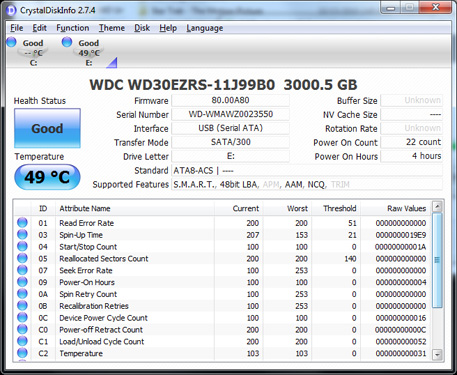
Like Seagate, Western Digital supplies software with the drive to manage the drive and backups. Western Digital doesn’t bundle a NTFS Mac driver so you’ll need to reformat the NTFS formatted drive for write use on a Mac (or supply your own NTFS driver for OS X).
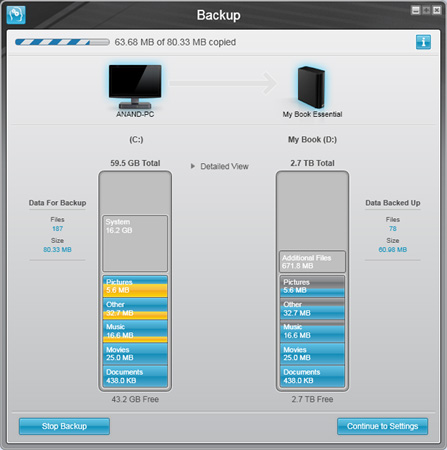
WD’s SmartWare utility does let you seamlessly lock and unlock the drive across both Windows and OS X however.

The performance of the My Book Essential isn’t nearly as good as what we saw with the GoFlex Desk. Seagate is over 25% faster for sequential reads and writes over USB 3.0. I’d say the tradeoff is worth it given the tremendous difference in heat however.
| External 3TB Performance Comparison | |||||
| Seagate GoFlex Desk 3TB (USB 3.0) | Western Digital My Book Essential 3TB (USB 3.0) | Western Digital My Book Essential 3TB (USB 2.0) | |||
| Sequential Read | 151.9 MB/s | 120.6 MB/s | 37.8 MB/s | ||
| Sequential Write | 151.2 MB/s | 119.7 MB/s | 32.9 MB/s | ||
| Random Read | 0.30 MB/s | 0.18 MB/s | 0.17 MB/s | ||
| Random Write | 0.93 MB/s | 0.84 MB/s | 0.82 MB/s | ||
USB 3.0 continues to be a great interface for external storage. There’s very little sequential performance difference between the 3TB My Book Essential and the desktop Caviar Green. Random performance is significantly lower, presumably because of the translation that happens at the USB controller level. As an external drive, you’re more likely to be writing to the My Book Essential sequentially rather than throwing a more random workload at it.


The only problem I had in testing the My Book Essential was very erratic read performance at the beginning of my testing. Here’s a shot of the first sequential read pass on the drive:
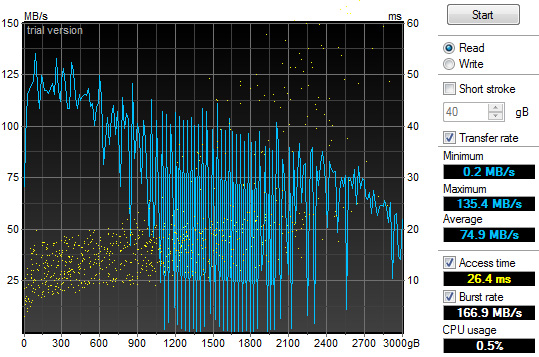
The problem mostly resolved itself after further passes, although there were always some strange performance blips aross various LBAs:
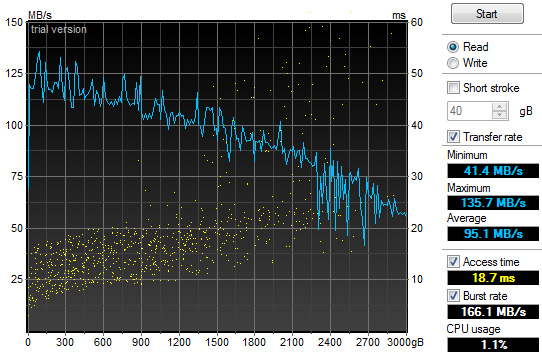
Write performance is also impacted:
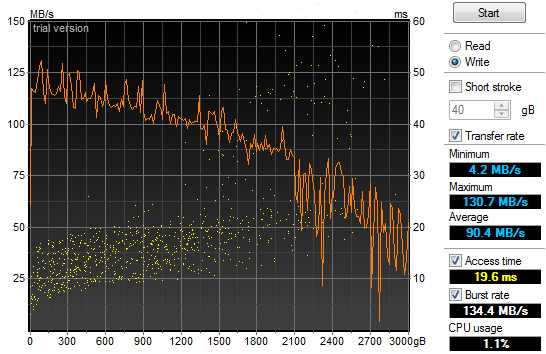
You'll notice that I didn't see these problems with the internal drive, which leads me to believe that this is either a problem with my review sample or with the USB 3 to SATA bridge in the My Book Essential itself. The variable performance also isn't consistent between runs or benchmarks

The move to USB 3 adds about a 3+ ms latency penalty compared to the internal drive. This is ok for backups and large file storage, but it's not something you'd want to use as an application drive.










48 Comments
View All Comments
mapesdhs - Wednesday, October 20, 2010 - link
I've been buying Samsung drives for a while, they are indeed pretty quick. I've
not compared to Seagate or WD, but I've added some Samsung HDTach data to
my benchmarks page for the 1TB editions of the Spinpoint F1 and F3, if it's of
any use:
http://www.sgidepot.co.uk/diskdata.html
At some stage I'd like to start testing random read/write with IOMeter, but finding
the time is a problem.
Ian.
EddyKilowatt - Tuesday, October 19, 2010 - link
Exactly. I think the fast/high performance end of the magnetic storage market will wither pretty fast under the onslaught of SSDs, except for increasingly niche applications that need fast access to 500-1000 MB of data.Meanwhile, as SSDs get solidified in the fast boot/app/cache role, the need for speed will further be relaxed for these big TB-class drives, and disk builders will feel freer to optimize for areal density at the expense of speed. I think we'll see lots of 5400 drives, and who knows... maybe 4200 and other speeds that till now have seemed like grandma territory. Anything that can originate a couple of full-HD video streams, or other media stream of your choice, seems like it ought to be viable for what will increasingly be the foundation tier of the ever-diversifying storage hierarchy.
AFUMCBill - Tuesday, October 19, 2010 - link
"The Essential suffix somehow implies USB 3.0 support."This is incorrect. The Essential suffix means USB only support, no eSATA, no FireWire. That USB support can be either USB 2.0 or USB 3.0.
kepstin - Tuesday, October 19, 2010 - link
It's not actually true that a classic PC BIOS can't boot from a GPT formatted disk - I'm doing that right now!The design of GPT incorporates backwards compatibility, including space for an old-fashioned MBR boot sector that can be loaded with a bootloader that knows how to read GPT. As a result, Linux boots just fine on a GPT partitioned disk, even on a classic BIOS PC.
The issue is specifically that Windows can't boot off of a GPT disk without EFI, because the boot loader that Windows uses on a BIOS machine doesn't know how to read GPT partitions.
Mr Perfect - Wednesday, October 20, 2010 - link
Can it read more then 2TB? I read it to mean that BIOS couldn't handle anything bigger then 2TB, regardless.Etern205 - Wednesday, October 20, 2010 - link
On page 2 , one of the images show a MBR partition HDD can be converted to GPT.If one has all the requirements, can they just use their OS disc to directly create a GPT partition instead of doing this conversion stuff?
R3MF - Wednesday, October 20, 2010 - link
Anand - will there be 2TB green drives based on these platters?tiro_uspsss - Wednesday, October 20, 2010 - link
there is no 150GB VelociRaptor in the benches/review.. ;)mapesdhs - Wednesday, October 20, 2010 - link
Here's what I get with HDTach for my WD VR 150GB:
Max: 132.0 MB/sec
Avg: 107.0 MB/sec
Min: 79.0 MB/sec
Burst: 248.0 MB/sec
Access: 6.9ms
Ref: http://www.sgidepot.co.uk/diskdata.html
What does IOMeter use as its definition of 1MB? 10^6 bytes or 2^20 bytes? I think
HDTach uses the former.
Ian.
Mr Perfect - Wednesday, October 20, 2010 - link
I've seen a number of sites now mentioning UEFI will show up in H1 of 2011. Is UEFI an official feature of the Cougar Point chipsets?